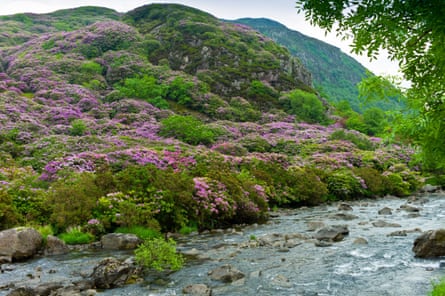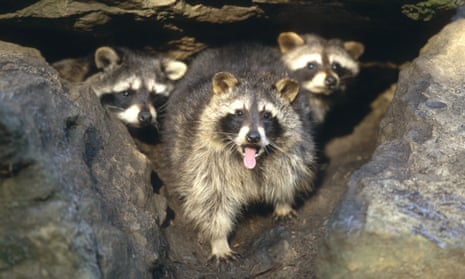The north American raccoon, an Asian hornet and an American cabbage are among 37 invasive species that will be banned from being brought into the UK from Wednesday when a new EU regulation comes into effect.
The continent-wide rules now make it illegal to import, keep, breed or grow, transport, sell or use, or release into the environment without a permit the listed invasive, non-native plant and animal species. But the ban will no longer apply when then UK leaves the EU.
The 14 plants listed include the American skunk cabbage, which has invaded Scottish marshes and wiped out all of the native flora at one site in the New Forest, Hampshire. Curly waterweed, also on the list, has increased by 41% in 15 years in the UK, while floating pennywort can spread at a rate of 20cm per day.
The list of 23 banned animals contains the aggressive North American signal crayfish, which breeds faster and preys on the smaller native crayfish species; the Asian hornet, which is spreading rapidly across France and other parts of mainland Europe, and the raccoon. As many as 1 million are believed to have spread across Germany, threatening native wildlife and carrying parasitic diseases.
The named species have been assessed as being “of union concern” - posing such a high risk of invasion and damage within one or more EU member states that a co-ordinated, Europe-wide response is needed to limit their spread.

Invasive alien species are animals and plants that are introduced accidentally or deliberately into a natural environment where they are not normally found. Around 1,800 species in the EU are considered invasive, and their numbers are rapidly growing.
They represent a major biodiversity threat by crowding out indigenous species and cause more than €12bn of damage every year.
Karmenu Vella, EU commissioner for the environment, said: “Some species of plants and animals can damage property, crops and livelihoods so they need to be kept out if possible and under control if not. This needs to be done at EU level as invasive species don’t stop at borders. We are acting on a problem that cannot be ignored.”
Invasive species in the UK have been controlled to date by the Wildlife and Countryside Act and the GB Invasive Non-native Species strategy and are estimated to cost the British economy around £1.7bn a year. Total annual costs of Japanese knotweed are estimated at £166m and some £13.9m of damage is thought to be caused by deer vehicle collisions each year - many of which are non-native species. An £11m bill has been set for the eradication of rhododendron from a national park in Wales.
A spokesperson for the Department for Environment, Food and Rural Affairs said: “We continue to take a robust and comprehensive approach to tackling invasive non-native species in the UK.”

The Wildfowl & Wetlands Trust (WWT) said the ban was welcome because the EU list contains several water-based species that can grow aggressively and choke native water life of light, oxygen and space.
WWT government affairs officer, Hannah Freeman, said: “This European regulation is a no-brainer that will save wildlife and also save our economy millions of pounds each year. It’s important that we continue to make those savings and keep managing harmful alien species once we leave the EU.
“Invasive non-native species is an ever-developing issue as climate and transport changes over time. This regulation is a welcome first step, but more steps will be needed in future to keep pace with the threats to Britain’s wildlife, whether we’re a member of the EU or not.”
Dr Trevor Dines, Plantlife’s botanical specialist, said: “Although harsh, these stringent new controls are one of the most effective ways to stop species at an early stage of the invasion process. It’s much better to nip them in the bud – getting on top of the problem now – before eradication at many sites in the wild becomes difficult and prohibitively expensive.”
Paul Hetherington, fundraising and communications director of Buglife, said: “Agreement on this initial, very modest list of species is a small but important step in controlling the invasive alien species that are threatening our natural heritage.”
The regulation was originally planned to come into effect in January 2015 but has been delayed until the list of regulated species could be agreed.
Member states have 18 months to implement effective management measures including a surveillance system, early detection and rapid eradication and control of the invasive species that are already widespread in their territory.
Breach of the regulation will result in a fine and seizure of the animal or plant. The rules also include special provisions for pet owners, traders, and breeders.
Full list of the EU’s banned invasive species
Plants
American skunk cabbage
Asiatic tearthumb
Curly waterweed
Eastern baccharis
Floating pennywort
Floating primrose
Green cambomba
Kudzu vine
Parrot’s feather
Persian hogweed
Water hyacinth
Water primrose (two species)
Whitetop weed

Animals
Amur sleeper
Asian hornet
Small Indian mongoose
Bryant’s fox squirrel
Chinese mitten crab
Coypu
Eastern crayfish
Grey squirrel
Indian house crow
Marbled crayfish
Muntjac deer
North American bullfrog
Pallas’s squirrel
Raccoon
Red eared slider
Red swamp crayfish
Ruddy duck
Sacred ibis
Siberian chipmunk
Signal crayfish
South American coati
Topmouth gudgeon
Virile (northern) crayfish

Comments (…)
Sign in or create your Guardian account to join the discussion